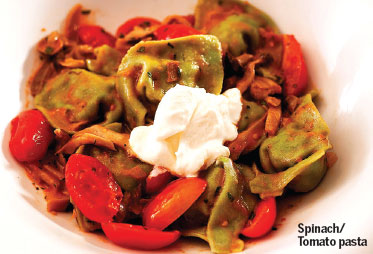There's always room for pasta with a good sauce at mealtimes
Updated: 2013-11-15 06:55
By Maggie Beale(HK Edition)
|
|||||||
Italian cuisine is rich and varied, and pasta has been its pride and glory throughout much of its history, and it's now a worldwide comfort food. But the origins of pasta are still as tangled as a bowl of spaghetti. Theories range from being 'brought from China by explorer Marco Polo'; to having been 'invented' by the ancient Greek God, Vulcan, or that pasta was introduced during the Arab conquests of Sicily in the 7th century.
Be that as it may, perhaps the most significant influence happened during the 16th century, when the Spanish brought their food discoveries back to the old world. Among those discoveries was the tomato. And the rest, as they say, is history as tomato sauce altered the story of pasta forever. If ever there was a perfect culinary match it is surely pasta and tomatoes.
Pasta can be enriched by sauces and ragout (stews) made from all kinds of seafood from grand crustaceans and tiny clams, to beef, pork and a variety of meats, many types of game - even rabbits and hares, and poultry such as chicken and pigeons.
Two of the most delicious pasta with chicken dishes are Pasta con Pollo alla Maddalena (Maddalena is a small island off the coast of Sardinia where Canadian actor Donald Sutherland was once a neighbour) and Pasta with Pollo alla Romana.
Traditionally, in Italy, unexpected visitors arriving at meal times were automatically invited to join in and an extra portion of dry pasta added to the pot, the individual portions of chicken downsized and the sauce stretched appropriately.
For some, the size and quality of the bird is of lesser importance, it's the flavor of the sauce that's the focal point. You can also use an old hen for a more economical sauce. It will require a much longer cooking time, a couple of hours sometimes, the end result for the chicken will not have the same succulent tenderness but the sauce will still be delicious.
To make a rich one-dish meal of pasta with Pollo alla Romana for 3 or 4 people, cut a free-range chicken into serving pieces or use free-range chicken wings cut at the joint to form two pieces. Unless you have dietary concerns, leave the skin intact, rub the pieces with salt and saut in 2 Tbsp olive oil in a saut pan. Keep turning the pieces around to brown each side, for 6-8 minutes total. Then add 2 rashers of bacon or pancetta chopped small, 1 large chopped onion, 4 cloves garlic and 1 bay leaf, and cook, stirring for 4-5 minutes. Add 1 tin of Italian tomatoes in their juice, 1 small bunch of chopped flat parsley, tspn each of dried oregano and rosemary, and 1 large glassful of *Italian wine and cook until the chicken is tender, around 30+ minutes. Add 1 Tbsp of seasoned flour (plain flour with a shake of salt and white pepper added) to the juice in the pan, stir well and cook for 2-3 minutes until it thickens a bit.
Instead, to make the chicken sauce Maddalena style, fry the pieces of best quality, young free-range chicken in 2 Tbsp olive oil along with 1 sliced onion, 4 cloves garlic, and 1 stick chopped celery until the chicken is golden, around 10+ minutes. Add 1 cup of chicken stock (ready-made organic versions are now available in stores), a handful of chopped flat parsley and 1 glass of Sardinian wine made from the carignan grapes or if you are able to find it, a Vernaccia di Oristano wine, a marvellously rich, fortified wine from Sardinia. Simmer until the chicken is done, around 25-30 minutes, test tenderness by sticking a fork into the fattest part. At that point add 10-16 black olives cut in half and let simmer for a minute or two before mashing 4 anchovy fillets into the gravy. Serve this ambrosial sauce over short pasta such as penne (see package for cooking instructions/times), topped by the chicken pieces.
Ideally, *the wine for the Pollo alla Romano sauce should be an Italian white, such as a white Frascati, made mainly from Trebiano grapes. It is a light wine that can be slightly off-dry, un-oaked it has a crisp acidity and subdued flavor; or one of my favourite Italian whites, Verdicchio from the Marche region: A dry, crisp, medium-bodied white with mineral notes and sea-air freshness. If you prefer you can add chicken stock instead, or opt for half wine and half stock.
Speaking of wine for cooking, I do believe that any dish requiring the addition of wine, benefits greatly from an honestly made wine. Of course, it doesn't have to be a Grand Cru, far from it, but neither should you opt for a real cheapie just because it's only for cooking. The difference shows, believe me. If in any doubt, stick to a readily available Spanish Oloroso sherry. I keep a bottle at hand in the kitchen fridge - it's a useful addition for many dishes.

(HK Edition 11/15/2013 page7)